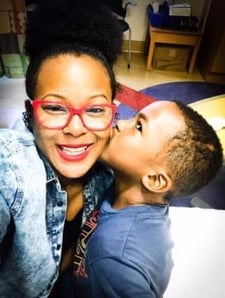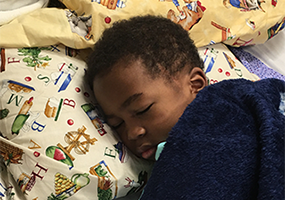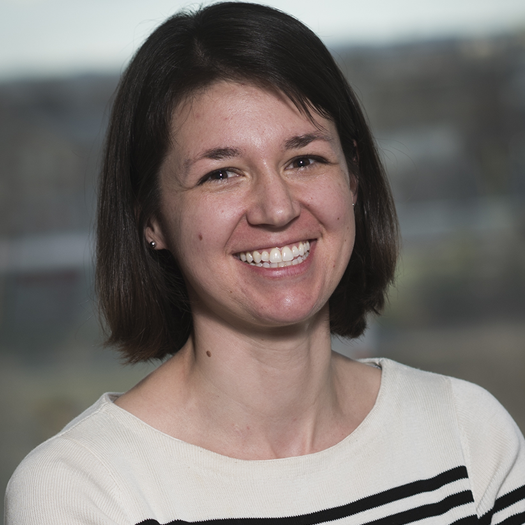
Bryce's Story

 At just six weeks old, Bryce Morgan was diagnosed with sickle cell disease, a blood disorder characterized by defective red blood cells and their inability to carry oxygen to the tissues of the body. The sickle-shaped red blood cells block blood flow through tiny blood vessels to the chest, abdomen and joints, often causing serious pain. Shortly after he was diagnosed, Bryce woke up from a nap with a twitch in his arm, which spurred his mother Jazmin – who also has sickle cell disease – to call Children’s National Hospital. Once at the hospital, medical experts told Jazmin that Bryce could be suffering from a seizure or stroke, symptoms considered severe for sickle cell patients.
At just six weeks old, Bryce Morgan was diagnosed with sickle cell disease, a blood disorder characterized by defective red blood cells and their inability to carry oxygen to the tissues of the body. The sickle-shaped red blood cells block blood flow through tiny blood vessels to the chest, abdomen and joints, often causing serious pain. Shortly after he was diagnosed, Bryce woke up from a nap with a twitch in his arm, which spurred his mother Jazmin – who also has sickle cell disease – to call Children’s National Hospital. Once at the hospital, medical experts told Jazmin that Bryce could be suffering from a seizure or stroke, symptoms considered severe for sickle cell patients.
That night was the beginning of a five-year stretch of strokes and medical complications for young Bryce.
At age two, Bryce began regular treatment, including blood transfusions, which help increase the number of healthy red blood cells. At age three, he was added to the bone marrow donor list in hopes of finding a match for a bone marrow transplant (BMT). BMT is the only treatment that can cure sickle cell disease, but less than 25% of patients who need a transplant have a sibling who can serve as a “perfect match.” Without a full sibling, Bryce would have to wait for the national donor list to produce a match, which can sometimes take years.
While waiting for a donor match, Bryce suffered from a variety of complications, including two back-to-back strokes that caused right-sided weakness and still affect Bryce today.
In August 2014, a third stroke brought about another diagnosis – Moyamoya disease, a rare, progressive cerebrovascular disorder caused by blocked arteries at the base of the brain in an area called the basal ganglia. Shortly thereafter in May 2015, Bryce underwent Encephalo-duro-arterio-synangiosis (EDAS) surgery to help create different pathways for his blood to flow.
Later that year, in June and September of 2015, his fourth and fifth strokes caused speech issues and spurred Jazmin to consider clinical trial options for Bryce. He had never attended school and Jazmin had been out of work due to his ongoing and unpredictable medical complications.
At just the same time, Jennifer Webb, MD, a hematologist at Children’s National and Bryce’s lead physician, introduced the family to Allistair Abraham, MD, a blood and marrow transplantation specialist. He was launching a cutting-edge, first-of-its-kind clinical trial to expand the pool of possible BMT donors.
 The trial utilized a haploidentical, or half-matched family member, as a transplant donor for Bryce. This novel approach eliminates the need for a perfect match from a sibling or the national donor list. Half-matched family members, such as a parent, are typically available options for most patients and make it possible for transplants to be offered more widely as a curative option for sickle cell disease.
The trial utilized a haploidentical, or half-matched family member, as a transplant donor for Bryce. This novel approach eliminates the need for a perfect match from a sibling or the national donor list. Half-matched family members, such as a parent, are typically available options for most patients and make it possible for transplants to be offered more widely as a curative option for sickle cell disease.
In January 2016, Bryce’s half-matched donor was confirmed – Jazmin’s father Vadon McDowell, a match that doctors describe as a miracle.
“Because of their family history of sickle cell disease, the odds of Bryce’s grandfather being a match were incredibly rare,” said Dr. Abraham. “We are so thrilled that Bryce gets another shot at a healthy, normal life thanks to him.”
Several months later in May 2016, Bryce and Jazmin, joined by his sister Zsani’Yah, his “NaNa” Valerie Ellis, and Jazmin’s fiancé Nadir Belt, enjoyed a trip to Disney World thanks to the Make-a-Wish Foundation. When Bryce returned, he underwent the BMT that would use medications to remove his bone marrow, replacing it with the blood-making cells from his grandfather, and eliminating sickle cell disease from his body.
Nearly one year later, Bryce is a healthy six-year-old, with no sickle cells producing as of today and no unexpected complications since the treatment. His BMT has replaced 85% of his marrow. He is slated to attend school for the first time this fall. Jazmin also plans to finish school and go back to work.
“Bryce’s optimism for such a young child is truly inspirational,” said Dr. Webb. “Today, you wouldn’t even know he’s had all these complications. He’s amazingly resilient.”
“He’s a hero to me. Always full of hope, always happy and positive,” said Jazmin. “I don’t think I would’ve been able to get through half of this journey without the team at Children’s – Doctors Abraham and Webb, his team of nurses – and Nadir, our family, and friends” said Jazmin. “They’ve been such a great support system from day one.”
Departments that Treated
Care Team


Be the Reason a Child Smiles
Every day at Children’s National Hospital, lives are changed through compassionate care and groundbreaking discoveries. Your charitable donation helps us deliver expert treatment and hope to thousands of children and families.
Meet the patients whose stories inspire us—and see the difference your support makes.







